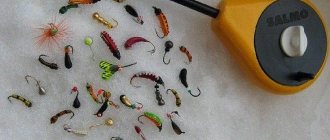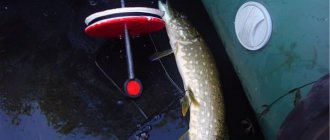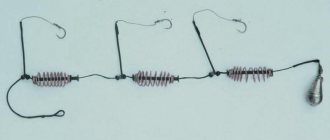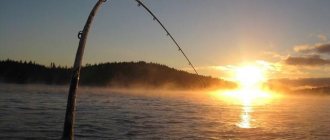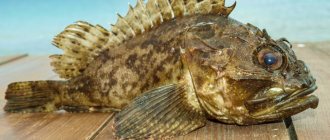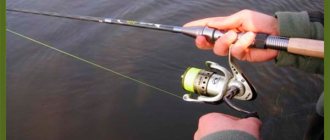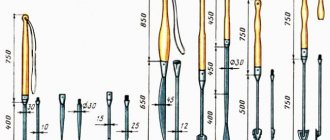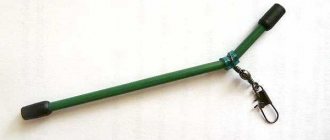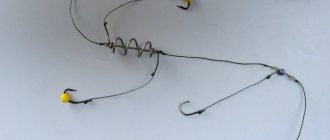Self-production
It can be performed in one of several possible ways and is used in cases where the fisherman has one well-made jig, which ensures a successful bite, and there is a need for a spare jig.
The use of self-made or special jigs is also due to the selectivity of crucian carp or the expansion of the fisherman’s capabilities. For example, so-called phosphorus prey simulators are used to catch crucian carp.
The name of this variety is arbitrary and is based on the association with phosphorus as a luminescent substance. The surface of the finished jig is covered with paint containing phosphors.
The advantages of using them are the possibility of fishing at night, increasing the efficiency of fishing at significant depths, and increasing the catch on cloudy days:
- The first manufacturing method is to select hooks No. 12-14 and tin them using tin-lead solder, zinc chloride and an electric soldering iron. After this, a cut is made in a piece of rubber to fix the hook in it. On the surface of the fluoroplastic plate in the extreme part, several holes of small diameter are drilled, corresponding to the size of the jigs being produced. The hook is located in the hole of the plate, after which solder melted with a soldering iron is applied to the hole with the hook. Hot solder must immediately be pierced through using a pin, which can be easily removed after the hooked solder has hardened.
- Making a jig from tin, lead, tungsten by cutting and filing the metal until the body of the jig is given the shape of a sample. A hole is made in the jig using a needle, after which, without removing the needle from the pointed part of the jig, a cut is made using a knife to deepen the shank of hook No. 2-4 into it. To prevent the hook from popping out, it is soldered. The cleaned shank of the hook, treated with flux and solder applied to it, is soldered to the body of the jig.
Winter fishing
lead jigs
To a large extent, the success of winter fishing depends on the correct choice of jig. The color of the simulator should be attractive to the fish, but natural for the given environment. The most suitable colors are those associated with crucian carp's favorite delicacies.
Among them: golden, silver, red colors, but in winter these colors do not fit into the environment.
When winter fishing, various gear of natural colors of the reservoir is used - tungsten, lead, brass, copper. It is better to choose light shades of bait color to create a contrast with the environment and jig material, but not stand out from the general background of the natural environment.
The best results are shown by winter artificial baits with a line diameter less than 2.5 mm , taking into account the greater weight of the fish in winter. The shape of this part of the tackle is also of significant importance, since ideally it imitates edible objects familiar to crucian carp.
The outline of possible prey is not as critical as the color, which does not differ from the environment. Good results are shown by the use of a form of prey simulator, a goat, in winter fishing, which in appearance resembles a small fish, but has a forked hook.
Forms of winter prey simulants used:
- lenticular with a lower part made of copper or brass;
- lead pellet;
- ant made in black or gray shades;
- diamond-shaped with a lower part made of lead or brass;
- lead bug;
- green, brown or black droplet;
- lead larva;
- lead barrel;
- devil;
- goat;
There are passive (with lowering gear to the bottom of the reservoir and waiting for a bite) and active types of winter fishing, which consists in manipulating a jig of a certain amplitude and frequency.
The nuances and features of winter fishing are presented in the form of recommendations:
- Fishing with winter fishing rods.
- preferable to equip the fishing rod with legs that will resist the drag of the tackle under the ice and create the possibility of resting it on the extreme edge of the hole to free up your hands.
As the depth of the fishing spot decreases, it is necessary to choose jigs of brighter colors:
- In clear weather, prefer prey simulators in darker shades.
- When using a passive fishing method, choose a float with brighter colors.
- The fishing depth should not exceed 1-3 m, since in winter fish will not be caught at greater depths.
For successful fishing there must be warm weather without frost and wind.
It is necessary to choose for fishing places of low water flow in a reservoir with a muddy bottom surface.
https://www.youtube.com/watch?v=zy7_sjBgo6Q
Nod for catching
The game options, as in winter, are tied to the design of the nod itself . One experienced jig maker advised me on specific designs and gave me a couple of his nods, telling me how to make a nod myself.
Then he started making them himself, making nods from lavsan. The length of the nod is 25-30 cm, so long it is easier to produce a measured game, and wiring failures in it are successfully smoothed out. On the nod there are two small unloading rings (for fishing line) made of plastic cambrics - in front and in the center of the Mylar plate. The attachment of the nod to the tip of the rod is traditional and as reliable as possible - from the same cambrics of different diameters, stretched over each other.
The distance from the eyes to the nod is no match for the winter one, under 6 m. Bites need to be clearly recorded, so I adjust the nod to the weight of the jig: without load, it is raised a little upward (as when fishing not a devil), and under the weight of the jig, the tip of the nod is bent below the horizon by 2-3 cm. I tried other options - I didn’t like it. Although some may like it, in any case, the working amplitude of the tip bending should be significant, at least within 3-4 mm. Otherwise, the “rising” bites will be poorly visible, and there are many such bites, especially leucorrhoea, the same rudd loves to peck like that. As an option, make a lateral nod rather than a straight one, extending from the rod at a right angle; then it is visible much better, and you can install a more rigid structure with less bending.
I have several working nods in stock, differing in rigidity, selected for different weights of jigs. Somewhere in still water, when the bite is weak, I use a very light bait. In frosty weather in autumn or in summer when fishing in duckweed, it’s harder. I use an even more voluminous and weighty jig in places with a moderate current, which pulls the bait a little, but it is required that it confidently sink to the bottom. When I move through diverse areas, I often have to change nods, but changing the bandage is a matter of minutes.
Learn more about how to choose a nod for a jig.
Characteristic features of summer fishing
- When fishing in the middle of summer, the water near the shore heats up quite strongly, so it is better to fish in deeper parts of the lake or river.
- Amateur fishermen recommend using regular side fishing rods rather than short ones when casting from the inside of the vegetation surface of the reservoir.
- It is necessary to take into account the higher illumination of the bottom of the reservoir in the summer when choosing the color of a prey simulator for catching crucian carp.
Baits for successful fishing are usually of animal origin. However, given the fastidiousness of crucian carp and its predilection for flour products and products with a pronounced odor, the composition of the bait may change. Crucian carp are extremely partial to certain baits of plant origin, such as steamed or boiled pearl barley.
Types of bait for fishing:
- One of the best bait options when fishing for crucian carp are dung worms, as they remain active in the water for a long period of time, attracting the attention of fish, which respond better to moving food. In addition, in terms of taste and specific smell, worms satisfy the taste preferences of fish.
- A successful bait for catching this species is considered to be maggots, bloodworms or worms, or, given the fastidiousness of crucian carp, a mixture of bloodworms and maggots. The maggot attachment is made in the head area, which creates a successful imitation of the natural look and increases the possibility of quickly catching fish. It is a good bait option, but it is not suitable for places where there are a large number of other fish, since they will eat the delicacy before the wary crucian carp.
- The role of bait for catching fish can be performed by insects and larvae of various sizes, including leeches, dragonfly larvae, grasshoppers, flies, and burdock moths.
- Dough is also a favorite delicacy of crucian carp. It can be made from corn, wheat and pea flour with the addition of garlic or anise.
Reasons for the catchability of summer jigs in autumn
The behavior of underwater inhabitants of freshwater bodies varies depending on the time of year. If at the beginning of autumn there continues to be a good bite on float and bottom fishing rods using plant and animal baits, then starting from the second half of October, the off-season begins for many fishermen. And only a few of them go fishing.
Before freeze-up, the fish continue to feed, accumulating nutrients before wintering. But at this time, representatives of the ichthyofauna switch to animal food. Most often these are worms, bloodworms and other insect larvae. Float and bottom fishing rods are passive, the bait sinks to the bottom, and the angler has to wait a long time for the fish to approach. Bait does not help at this time either, because the water becomes cold and the aroma does not spread over a large area of water.
- A lateral nod allows you to explore the entire horizon, from the bottom to the surface layer. Depending on weather conditions, the flock may move vertically during the day.
- The next reason for the catchability of a summer jig is constant play with bait. The fish is attracted by the shine of the jig, it pays attention and notices the bloodworm or worm.
- In the autumn, the fish gather in schools and stay at depth, in thickets of grass or snags. Thanks to the long rod and wading boots, it is possible to accurately deliver the bait into a small window of clean water.
- Fishing with a side nod in late autumn is characterized by mobility. Within a short time, it is possible to explore many promising areas of the reservoir and find a feeding flock. During the fishing process, it is quite easy to determine the direction of movement of the school and slowly follow it.
Photo 1. Rural pond in autumn.
Techniques for catching crucian carp
For successful fishing, which is essentially a game between fish and fisherman, the latter needs to use various movements of the gear to simulate the natural behavior of a possible victim of crucian carp.
We place the bait on the hook of a crucian carp catch simulator, after which, simulating the most natural fall of the bait into the water, we lower the tackle into it. Deepening of the gear should be done using slow movements with stops.
However, when the tackle is immersed in water, there should be no sagging of the fishing line; the rod should be slightly raised. To increase the chances of successfully catching fish, the method of smooth and slow lifting of the tackle with short periods of stopping is used, during which the jig can be pulled to imitate the movements of the prey and attract fish.
The jig goes deep into the water with calm movements of oscillatory amplitude, with periodic stops and movements at approximately equal intervals.
Ways to play tackle:
- The prey simulator sinks to the bottom and remains there, at this time the fishing line is located at the edge of the hole or on a stand. After this, it is necessary to tap the jig on the bottom of the reservoir, after which, begin lifting the tackle with the same intervals of movement and stopping. When fishing in winter, move the tackle to the other edge of the hole, where you repeat the game; When fishing in summer, deepen again.
- The jig descends to the level of the bottom of the reservoir, touches it, after which it begins to rise at a slow speed of approximately 40 cm without oscillatory movements. After this, the deepening and raising of the production simulator is repeated. After the jig touches the bottom, a layer of silt rises, and the crucian carp gets the impression that a larva or insect has emerged from the silt and is trying to surface.
- , the prey simulator lowers to the bottom of the reservoir, lingers there for a few seconds and with the same leisurely movements rises 5 cm, then the cycle is repeated.
- Wiring while moving in different directions , when performed correctly, is a successful way to attract this type of fish. This method consists of making slow movements of the bait and periodically raising it a few centimeters. If the part of the rod called the nod starts to vibrate, it means a fish is trying the bait.
There are several signs that a fish is on the hook: the fish nods periodically or bends sharply. In this case, it is necessary to hook the crucian carp, which is important to do quickly but gently, given the fragility of the labial arches of this type of fish and their inability to withstand loads.
Fishing with a jig in the fall
A small and remote jig can be so effective in the fall that some floaters exclude a hook from their gear and fish only with a jig, which acts as a catcher. And, of course, autumn is the time for jig fishing with a nod - skilled fishermen continue to experiment in this direction and do not complain about their catches.
My jig fishing is somewhat unique, and I use jigs more widely. I divide my fishing into three types: plumb, with a float, and casting with wiring.
Plumb jig
I have been fishing with a nod for over ten years, and usually with a reel. The rod must be well balanced. The general idea is to install a coil near the butt as a kind of counterweight. As for the game, it is very difficult to work with a jig on a long whip; the game often turns out to be inaccurate.
What if you play with bait through a fishing line? I liked it, and now I often fish like this: I take the rod in my right hand without moving it, and I make “twitches” for the jig with my left hand through the fishing line. The game is much clearer, and nod bites are more noticeable. But I carefully make sure that all the passage elements of the nod are smooth, so that the fishing line slides easily, without the slightest delay.
Float jig
A float greatly expands the capabilities of a jig fisherman (essentially, this is a different piece of equipment), allowing you to fish not only under your feet, but also at a decent distance, which is especially important on rivers. I use a float with one attachment point, not on the float itself, but on a wire coupling with a fishing line passed through a plastic cambric. This hitch allows you to play along, twitching the jig away from the angler, and hold the float in the current, practically without disturbing the water surface, that is, without scaring away the fish.
I make the float from soft packaging foam - soft, because it is light enough and does not have the inertia of dense foam. Excessive softness can be eliminated by covering it with several very thin layers of epoxy resin. At the top I glue an antenna from any plastic stick, at the end of which I glue an epoxy ball. I paint the antenna in contrasting colors, and the float itself resembles natural wood, to which the fish are accustomed. As for the shape of the float, it is the thick bottom that allows it to be more stable in the current. As for greater bite resistance, a fish irritated by a jig is usually very bold, and especially in the current. By controlling such a low-sinking float in the current, you can take it almost like a boat into any nook and cranny of the river. And the presence of a lower mount allows you to play with the bait, minimally disturbing the fish with the “crushing” characteristic of a traditional float.
And one more significant difference between a float jig and a regular jig is the mandatory presence of a nozzle; only with it, fishing with a float using a jig will be successful - the choice of nozzles is the widest.
Casting jig
This fishing is reminiscent of spinning jig fishing. The catchability of such gear, by the way, is remarkable in the fall - literally all the fish are caught. Of course, there is no spinning rod that feels well and casts a jig weighing half a gram, so the role of a jig tip is well performed by a nod made of fishing line with a diameter of 1 mm, taped with electrical tape parallel to the tip of the spinning rod. All that remains is to make a loop through the free edge of this improvised nod - in any suitable way.
My jigs, used in such jigging, cannot boast of any special delicacies - anyway, the fish are unlikely to notice and appreciate them. The best option is a hook with notches on the fore-end, on which a pellet is clamped and a worm, leech, fish cutting or a strip of silicone is attached. In general, in ordinary (not spinning) jig fishing, the shape, size and color of baits are of significant importance, because the fish can thoroughly examine the bait in place. I won’t say which jig is better - all are good, depending on the fishing conditions, so it’s better to have a sufficient supply of diverse models with you.
You can cast a jig using either a float or a spinning rod, even with a fairly decent cast - you just need to have a spool with a thin line in stock and attach a suitable nod.
Fishing Features
Despite the fact that fishing with a nod in open water has begun to progress, at the same time, one cannot help but admit the fact that in many regions of the country you rarely see this tackle in action, but it is very catchy, sporty, and exciting.
I believe that in the fall, rivers are more suitable for such fishing, because, despite the cold snap and lower water temperatures, fish are still common near the shores, and it is quite possible to do without a boat in the depths approaching the shore.
Fishing in the waters
Suvodi is an excellent place for fishing, because a wide variety of food swirls and lingers here. And in terms of fishing technique, it’s a simple place; often you don’t even need to work with a nod here, especially if the water jets are spinning decently. Usually I just slowly lower the jig into the very epicenter of the whirlpool and give it a pause - I hold the rod motionless, holding it under my elbow. Then the current itself plays along with the bait, carrying it in a circle - the jig is often carried out on its own right under the fish’s nose, and a bite follows.
If the current can’t handle it, I need to help it in a couple of minutes - I start working with a jig. Using a fishing rod obliquely, I smoothly and slowly move the bait out of the sector of the circular current to a calmer point. Then I lower it to the bottom and try different playing techniques. Sometimes a different way to remove the jig from the suvodi is very effective - with the shortest but sharpest jerks possible.
There are differences between waters, both in the strength of the current and in depth, and for clear control of fishing, jigs of radically different weights may be required. It happens that you catch roach, silver bream, and white bream with a small tungsten bait of half a gram on a piece of worm or bloodworm. And sometimes, in powerful waterways at depths of 3 meters, you have to use heavy homemade jigs weighing 10 grams, or even more, my weight limit for jigs is 15 grams! Usually, voluminous decoys are more perch-like things. Large perches are very fond of deep snags, which, by the way, are rarely fished with other gear - there are too many dead hooks. And with a jig - just right, the main thing is not to make a mistake in the process of fishing, quickly moving the perch into half-water (away from the snags), and only then calmly fishing.
Most often, I catch perch using a piece of creeper 2-3 cm long, dressing it not with a stocking, but simply piercing it across. When fishing for perch, it is not at all necessary to lower the bait into the water absolutely silently. Rather, on the contrary, the striped predator is attracted by the plopping of a heavy jig on the surface of the water. Another thing is more important - to maintain camouflage, not to stick your head above the shore, not to crack branches under your feet (especially in calm, calm weather), that is, it is important not to make noise yourself, scaring off the fish, because fishing is short-lived. And this applies not only (or rather, not so much) to perch, but also to all other types of fish of decent size.
It is ideal to fish along overgrown banks, where there are usually plenty of fish, and they are not so careful. Often walking along the river, you clearly see a place where someone is definitely standing in ambush - a crust protruding from the water, a bush of algae, an interesting sinkhole under the shore, etc. But I try never to lower the jig directly onto the fish’s head - it’s better to lower it two or three meters upstream and float the bait to the place where the fish is supposed to stay - this technique is always more effective.
And finally, about the advantages of large jigs: if the fish responds to them normally, then great - you can use thicker fishing lines, up to 0.3 mm, which adds confidence when fighting large fish.
Blitz tips
- One of the methods to increase the bite is to start fishing with bait made from boiled pearl barley grains; if the fish does not start biting, start fishing with animal baits.
- It is advisable to install the jig at an angle of 45°, taking into account maximum accessibility to the bait and hook in this position.
- When hooking crucian carp , like other types of fish, it is advisable to use only your hand.
- When playing with tackle and making moves, your hands should be relaxed and relaxed.
- Experienced anglers recommend using both hands to hook fish or using a tandem rod.
- When choosing a prey simulator , it is necessary to take into account the depth of the reservoir in the place where the fishing will be done; as the depth decreases, the size of the prey simulator should also decrease.
- When conducting a retrieve , use a smooth dive and movement with a large amplitude but low speed, since sudden movements can produce the opposite effect instead of attracting fish.
- If the crucian carp ignores the bait , it is recommended to replace the prey simulator with a copper or brass one. As a rule, colors of similar shades will attract fish, but if the bite does not occur, you need to change the jig to a lead jig - dark or brown.
